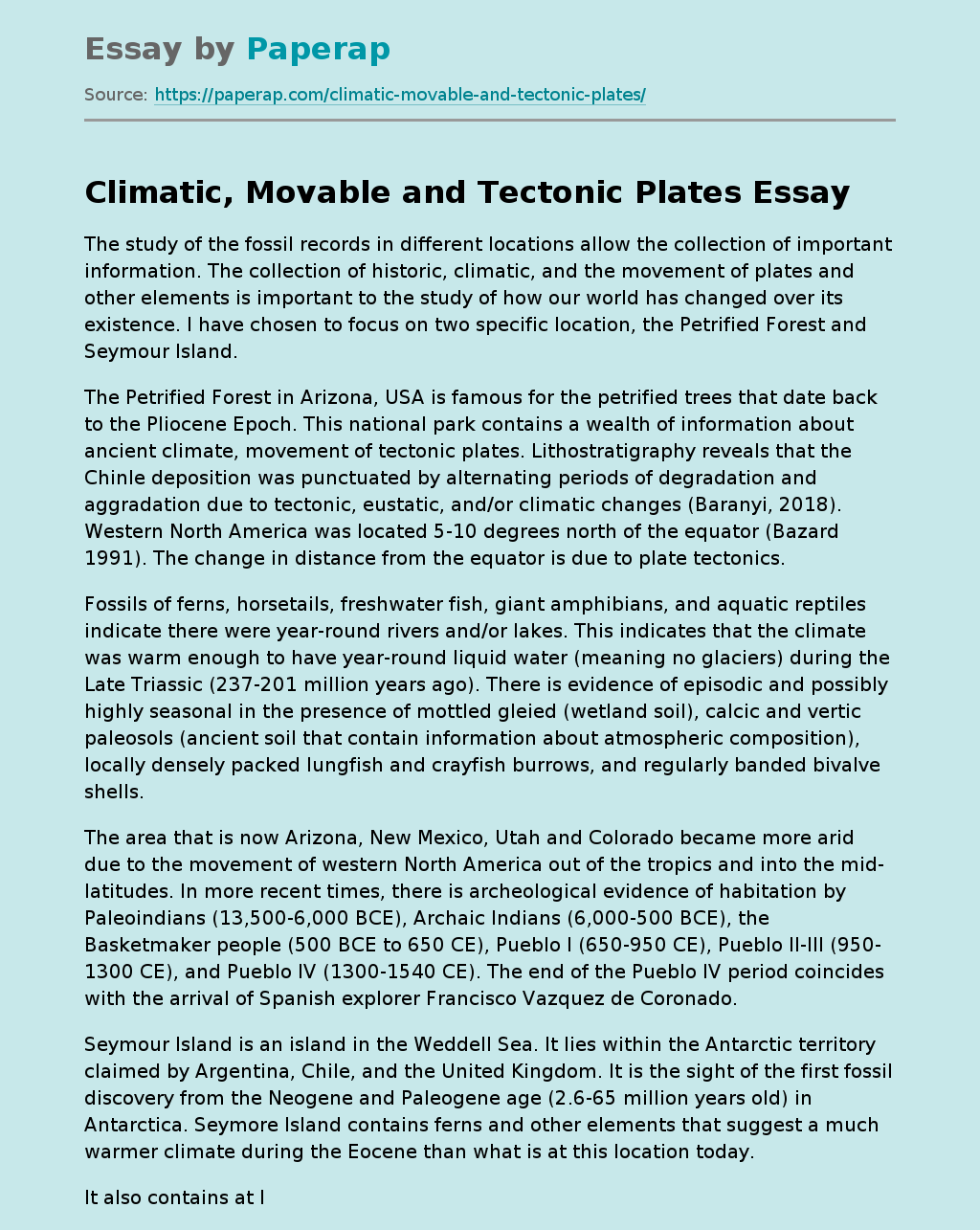Climatic, Movable and Tectonic Plates
The study of the fossil records in different locations allow the collection of important information. The collection of historic, climatic, and the movement of plates and other elements is important to the study of how our world has changed over its existence. I have chosen to focus on two specific location, the Petrified Forest and Seymour Island.
The Petrified Forest in Arizona, USA is famous for the petrified trees that date back to the Pliocene Epoch. This national park contains a wealth of information about ancient climate, movement of tectonic plates.
Lithostratigraphy reveals that the Chinle deposition was punctuated by alternating periods of degradation and aggradation due to tectonic, eustatic, and/or climatic changes (Baranyi, 2018). Western North America was located 5-10 degrees north of the equator (Bazard 1991). The change in distance from the equator is due to plate tectonics.
Fossils of ferns, horsetails, freshwater fish, giant amphibians, and aquatic reptiles indicate there were year-round rivers and/or lakes. This indicates that the climate was warm enough to have year-round liquid water (meaning no glaciers) during the Late Triassic (237-201 million years ago).
There is evidence of episodic and possibly highly seasonal in the presence of mottled gleied (wetland soil), calcic and vertic paleosols (ancient soil that contain information about atmospheric composition), locally densely packed lungfish and crayfish burrows, and regularly banded bivalve shells.
The area that is now Arizona, New Mexico, Utah and Colorado became more arid due to the movement of western North America out of the tropics and into the mid-latitudes.
In more recent times, there is archeological evidence of habitation by Paleoindians (13,500-6,000 BCE), Archaic Indians (6,000-500 BCE), the Basketmaker people (500 BCE to 650 CE), Pueblo I (650-950 CE), Pueblo II-III (950-1300 CE), and Pueblo IV (1300-1540 CE). The end of the Pueblo IV period coincides with the arrival of Spanish explorer Francisco Vazquez de Coronado.
Seymour Island is an island in the Weddell Sea. It lies within the Antarctic territory claimed by Argentina, Chile, and the United Kingdom. It is the sight of the first fossil discovery from the Neogene and Paleogene age (2.6-65 million years old) in Antarctica. Seymore Island contains ferns and other elements that suggest a much warmer climate during the Eocene than what is at this location today.
It also contains at least 10 mammal taxonomic ranks. Most of these are tiny marsupials and the endemism suggests that the marsupials of Patagonia are derived from the fauna fossils found on Seymour Island. The presence of sudamericids fossils indicates that the isolation on Seymour Island allowed the extended survival of this Gondwanan group in the Eocene. Notoungulate fossils present in Antarctica but not in Patagonia allow for speculation that the notoungulates could have passed into Antarctica during the latest part of the Paleocene, when the environment was warmer, and then became extinct at onset of the climatic deterioration during early Eocene and before the dispersal of marsupials into Patagonia.
During the Triassic period the continents were still close to the original Pangea formation. The break-up of Pangea began in the mid-Triassic. The movement of the plates illustrated by the change in climate in the fossil record in the Petrified Forest is supported by the later mammal movement from what is now South America to Antarctica to Patagonia. The effects of the changes in climate for the two locations were drastically different. The support of human life in the Petrified Forest shows that the movement of that part of the land stayed within the narrow band of survivable latitudes for humans.
The lack of human fossils and the discovery of the uninhabited island in 1853 shows that it was outside the survivable latitudes for humans until recent technological changes made it more accessible. While factors other than specific location in the world contributed to the local temperatures for both locations, both locations provide valuable information about the atmosphere in the region and from their time period.
Climatic, Movable and Tectonic Plates. (2021, Dec 15). Retrieved from https://paperap.com/climatic-movable-and-tectonic-plates/

